
The U.S. pet food industry includes 518 manufacturing facilities registered with the Food and Drug Administration (FDA), according to the new “2025 Pet Food Production and Ingredient Analysis” report from the Institute for Feed Education and Research (iFEEDER), American Feed Ingredients Association, North American Renderers Association and Pet Food Institute.
Though the report emphasizes that these facilities vary in size and production volume, it also provides some averages: Each of these 518 pet food plants buys, on average, 18,277 tons of ingredients a year, worth US$25.1 million from farmers and farm-product processors.
Lara Moody, executive director of iFEEDER, will provide these and other highlights from the report during Petfood Forum 2025 on April 29 in Kansas City, Missouri, USA. Her presentation will be one of several offering deep dives into the U.S. and global pet food markets, covering ingredients (including novel proteins like insects) as well as health and wellness trends, plus how data gathered by direct-to-consumer pet food companies about their end consumers (mainly dogs) helps inform product development.
Comparing pet food production by state
The 518 FDA-registered pet food manufacturing facilities reside in 441 U.S. cities across 43 of the 50 states, according to the new iFEEDER report. While some areas and states have higher concentrations of pet food plants, that doesn’t necessarily correlate to the number of pets or amount of pet food sold in those areas.
“Consumption of pet food is not necessarily close to points of production,” the report states. “It is not a stretch to say that pet food produced in Missouri can be purchased in Washington, California, Texas, Maine or Florida. Likewise, pet food ingredients are sourced locally, regionally, nationally and internationally.” In addition, pet food companies buy their ingredients through a variety of purchasing channels, including direct from farm, through brokers, direct from farm-product processors and from renderers. (The report breaks down that sourcing in detail.)
This complexity means that the leading states for pet food manufacturing and ingredient purchasing vary depending on which metric you’re applying. For example, Pennsylvania has the most facilities, 57, and that’s the main reason it ranks third in the U.S. for overall pet food ingredient purchases; the average size of those 57 facilities is below the national size average. “On the other hand, South Dakota has just two pet food manufacturing facilities, but they are more than twice as large as the national average,” the report says.
The top two pet food ingredient-purchasing states are Missouri, with a total of 1,1 million tons purchased in 2024, followed by Kansas, with 1 million tons purchased. Pennsylvania is actually a distant third at 727,000 tons.
When it comes to average purchases of pet food ingredients, Alabama, Arkansas, South Dakota, Kansas and Missouri rank highest, with 2024 averages of US$100.8 million, US$88.1 million, US$68.1 million, US$65.4 million and US$63.1 million, respectively. All are significantly higher than the national average of US$25.1 million. Pennsylvania’s average is only US$18.2 million, proving the point about how the pet food ingredient purchasing picture changes based on the metric.
Significant economic contributions
Across all the states and facilities, pet food ingredient purchasing in 2024 added up to 9.28 million tons worth US$13.2 billion. Bottom line: When viewed through the prism of ingredient purchasing, the U.S. pet food market is thriving and contributes significantly to the national and individual state economies.

















